Hittites 1700 to 1200 BC
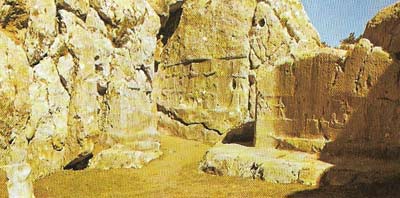
Figure 1. The impressive sanctuary of Yazilikaya is open to the air and is cut from the rock outside the walls of Hattusas, the Hittite capital. Spectacular reliefs are carved on the sides of two chambers, which are approached through an elaborate gateway. They depict processions of gods, goddesses, and kings, many of the deities being shown with their cult animals, weapons, and symbols. Some of the gods are the patrons of Hittite cities and all are named in hieroglyphic script. The principal scene shows the weather god Teshub standing on deified mountains; facing him are his consort and his son and beneath him are the gods of the Hurrian pantheon. During the later years of the empire, Hittite religion came under strong Hurrian influence, as the carvings here illustrate.
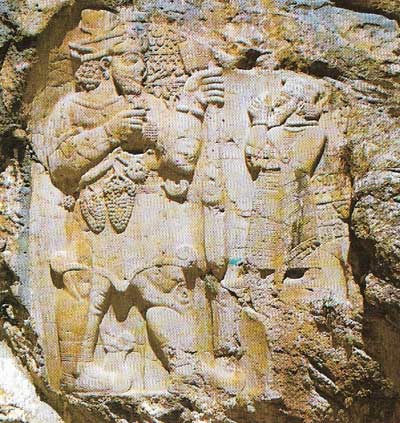
Figure 2. The rock carving at Wiz in the Taurus Mountains exemplifies the Aramaean style in Hittite sculpture, as is shown in particular by the god's cap and by the ringlets and profiles of both figures. But while the king wears an Assyrian cloak of a kind familiar from the royal statue from Malatya, the god's clothing has little that cannot be paralleled in purely Hittite sculptures, including the clear curved seam above the knees. The combination of relief and script facilitated the grouping (in 1880) of similar monuments reported from elsewhere in Asia Minor, notably at Bo'gazkby and Yazilikaya, as Hittite. The inscription names the king as Warpalawas (about 730 BC), so dating the relief.
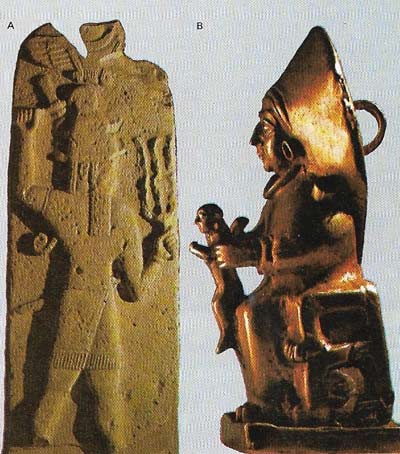
Figure 3. Among the chief deities in the Antolian pantheon were the weather god, Teshub (A) and the sun-goddess of Arinna. Teshub is shown in a ninth-century statue in his customary pose, wielding a flash of lightning; for unlike Mesopotamia, Anatolia is a land of cloud and storms. To the sun-goddess, shown in a pendant of the empire period, the king appealed for help in times of war and danger; she was supreme patroness of the Hittite state.
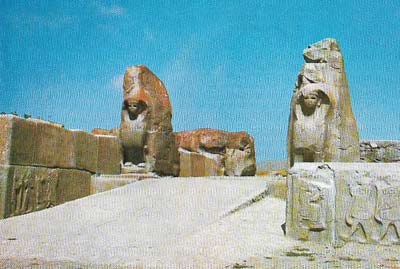
Figure 4. In the sphinx gate at Alaja Huyuk in central Turkey, the sphinxes – unusually for Hittite art – are sculpted partly in the round. Many reliefs were found in the ruins, depicting animals, musicians, jugglers, and a shepherd with his flock. Pre-Hittite tombs of the third millennium were also discovered there and contained silver and bronze animal figures, golden jugs, goblets, and ornaments.
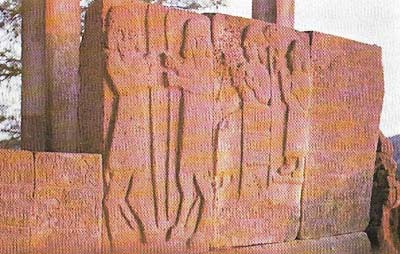
Figure 5. The excavation of Karatepe, northeast of Adana, revealed a bilingual inscription, one text in hieroglyphic Hittite and the other in Phoenician, which confirmed and amplified the decoding of the Hittite.
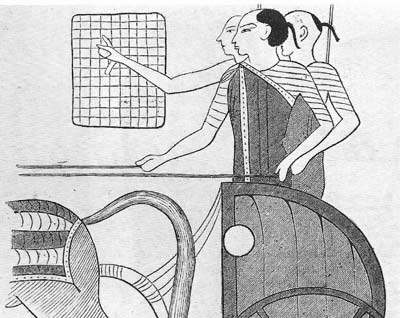
Figure 6. Use of the light seat chariot, shown in this drawing of an Egyptian relief, accounted in part for the Hittites' military successes, particularly the drawn battle at Kadesh (1299). Hittite chariots differed from those of Egypt and other nations of the period in that they carried three men – one driver and two fighters – instead of the usual one driver and one fighter. The main tactical aim of the Hittites in battle was to draw the enemy into the open where the chariots would be most effective. But their planning was not based solely on that maneuver. A clever ruse, for example, caught the Egyptians entirely by surprise at Kadesh, and only bad luck prevented an overwhelming victory.
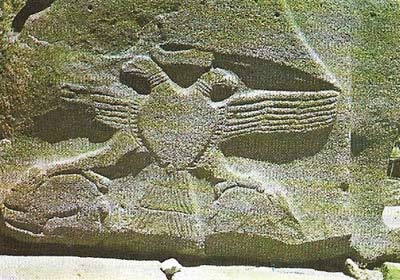
Figure 7. A double-headed eagle is carved on the back of a sphinx at Alaja Huyuk in Turkey, a city of the empire period. It is clutching in its talons two hares with their faces turned outwards like the eagle's heads. A figure, now badly damaged but perhaps a goddess, stood on the eagle's back. The same double-headed eagle motif appears also as a base for two standing figures among the sculptures of Yazilikaya. A double-headed bird appears elsewhere in the ancient world, for example on an early geometric-period ivory from Sparta, and on a shrine at Taxila, and survives on the banners of the Kandyan chiefs.
A hundred years ago knowledge of the Hittites was derived only from mentions in the Bible and in Mesopotamian records, but then, in the nineteenth century, discoveries began in Turkey of monuments and massive fortifications which had obviously survived from a flourishing and powerful civilization. This civilization was quickly identified as Hittite. What finally brought these peoples into vivid life was the discovery at Bogazkoy, the site of the Hittite capital Hattusas, of more than 10,000 cuneiform tablets. The tablets were written in several languages, including Akkadian, Hattian, Hurrian, Luwian, and Sumerian as well as Hittite, and were found to be the state archives.
Origins of Hittite civilization
Little is known about the earliest period of the Hittite civilization before contact with Mesopotamia. The Hittites came into Asia Minor before 2000 BC from Europe or southern Russia. In the middle of the 17th century BC King Hattusilas I seems to have united a number of small states and established his administrative center at Hattusas. Hittite power evidently grew rapidly, for in the early sixteenth century BC Mursilis I was able not only to occupy Syria but to march on Babylon, sacking the city and bringing to an end the dynasty of which Hammurabi was the greatest figure. The last king of the so-called Old Kingdom was Telepinus (reigned c. 1525–1500 BC), who is best known for his edict laying down rules of con-duct for the nobles and the king.
After a period of which there are few records, the Hittite Empire began about 1460 BC. The first king of the new dynasty was apparently Tudhaliyas II, who is said to have captured Aleppo. Mitanni, a state founded by the Hurrians in northern Mesopotamia, seems to have kept further Hittite expansion in check.
The situation changed radically when Suppiluliumas seized the throne in about 1380. He fortified Hattusas and in a brilliant campaign conquered Mitanni and its Syrian satellites. Carchemish, which commanded an important crossing point on the Euphrates, remained independent, but Suppiluliumas then led a second campaign, captured this fortress and occupied all of Syria between the Euphrates and the ocean.
Suppiluliumas died in about 1346 BC; his son Mursilis II proved equally capable, defeating the kingdom of Arzawa to the west and suppressing a revolt in Syria. The next king, Muwattalis, inherited a secure and prosperous empire. But Egypt was determined under Ramesses II (reigned 1304–1237 BC) to regain the possessions and influence she had lost in Syria. The two armies met at Kadesh (Figure 6) on the River Orontes. Egypt claimed an overwhelming victory, but the Hittites seem, at least, to have held their own and maintained their ascendancy in Syria. Relations between the two powers improved as Assyria became more of a threat, and in about 1284 BC they signed a treaty of friendship and non-aggression.
The end of the Hittite Empire
The records of the Hittite Empire end abruptly in the late thirteenth century BC, when Indo-European invaders known as the "Sea-Peoples" poured into the area from Europe. The Hittites fled southwards as the Phrygians overran Asia Minor. But although the homeland was lost, the Hittite way of life survived as the refugees established city states in northern Syria, which had so long been under Hittite control. Most of the archaeological evidence comes from this neo-Hittite revival rather than from the early imperial period. The writing of these petty kingdoms is hieroglyphic Hittite, but the language was essentially Luwian, so that we may assume that the Hittites did not necessarily form the majority of the population.
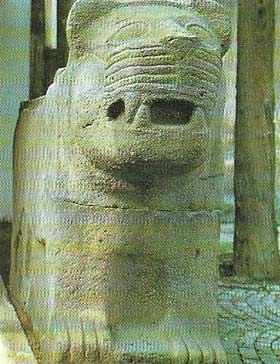 |
| This basalt carving of a lion, dated probably about 1000 BC, is fairly typical of the sculpture of the neo-Hittite period, when the use of stone lions to flank entranceways was not uncommon. |
Structure of Hittite society
The neo-Hittite city states, which were often isolated geographically, were unable to unite effectively against the growing power of Assyria. After exacting tribute over many years and putting down occasional rebellions. Assyria, under Tiglath-Pileser III (reigned 744–727 BC), decided to incorporate the Syrian kingdoms into its empire, and by the end of the 8th century BC the Hittite Empire was little more than a memory.
During the period up to the end of the 13th century BC the Hittite king, although perhaps not quite such a dominant figure as in Mesopotamia, made the final decision on military, religious and judicial matters. On his death he joined the gods, and indeed "he became a god" was a euphemism for the death of a king. The queen was also important, having a role to play in state affairs. Nepotism was institutionalized, most of the highest offices falling to the king's relations. There seems to have been an exclusive caste of privileged nobility and landowners. The common people worked as farmers, craftsmen and laborers, and those of the servant class, while having some legal rights, were little better than slaves.
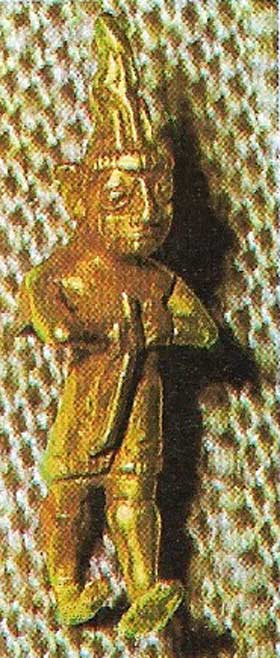 |
| Most surviving Hittite sculpture takes the form of monumental bas-reliefs in stone, often with inscriptions in hieroglyphic (as distinct from cuneiform) Hittite. The almost total absence of sculpture in the round is partly compensated for by a few beautiful miniature figures like this gold statuette (4.2 centimeters (1.7 inches) high) of a man, perhaps a king, wearing a full tunic with short sleeves. It was found at Yozgat, near Booazkoy, and dates from about the fourteenth century BC. |
The brutality that so disfigures the history of Assyria was quite lacking among the Hittites. A city captured in war suffered grave retribution in that it was generally destroyed and its inhabitants enslaved, but we know of no mass killings or systematic torture such as Assyria's enemies could expect. Similarly, punishment for crime was generally based on restitution to the injured party or his relatives, even in the case of murder.
